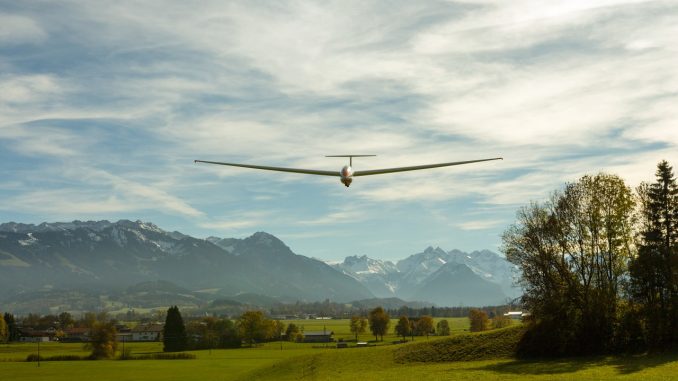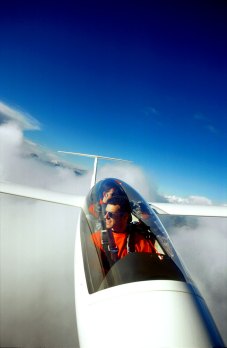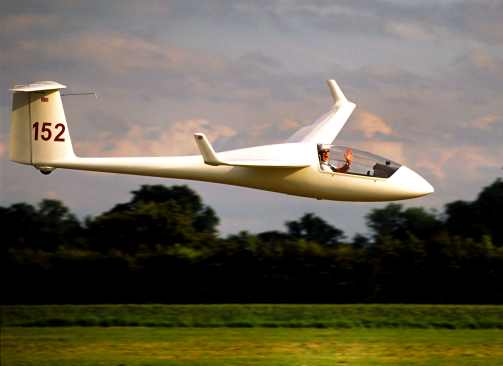
Gliding is the most wonderful experience of flying an unpowered plane using just the wind, updrafts and thermals to provide lift. Silently swooping and soaring over the landscape, you gotta try it.
Gliding experience gifts from Red Letter Days
Skills – Strength: 1, Balance: 5, Flexibility: 1, Agility: 1, Coordination: 6
Time needed: travelling time + 1 hour, Cost to try: £60
Gliding is, quite simply, the most fun you will ever have in the air!
A glider is like a small aeroplane, with one important difference – it has no engine. Glider pilots use the sky’s own energy to stay airborne and, by reading the sky and following the weather, pilots are able to achieve feats that non-glider pilots find hard to believe. The world distance record for a glider flight is over 3000km (that’s further than London to Moscow!) and even in this country, where the weather isn’t quite so good, flights of over 1100km have been recorded. Modern gliders fly at speeds of up to 250kmph and can reach heights well in excess of 30,000ft.

(c) www.whiteplanes.com
You are allowed to fly solo at 16 and most clubs will allow you to start training when you are around 14 or 15. Many young pilots do this and go solo on their 16th birthday each year. Once you have gone solo, you can start to really go places – flying cross country, taking part in racing competitions, getting into glider aerobatics, or just pushing yourself to go further, higher or faster than ever before.
The UK has a great record in international competitions and three out of the last four world junior champions have been British. There is a great junior scene (because you can’t go solo until you are 16, you are classed as a junior in gliding terms until you are 25!) with dedicated competitions, events, parties etc.
Glider pilots come from all walks of life and it is one sport where males and females can (and do!) compete on an equal basis. Many people think it has to be an expensive sport – wrong! Club members can take a half hour flight typically for as little as £15-£20 and most clubs offer young members flying at further reduced rates.
There are about 100 gliding clubs spread throughout the UK, including a good number of university clubs. You can find a complete listing along with further details about the sport at www.gliding.co.uk. For now though, here’s a bit more information:
Gliders
Gliders come in many shapes and sizes. They can also be cheap or expensive! Fortunately, you don”t need to buy your own glider – all clubs have two-seaters for instructional purposes, and most also have single-seaters which you move onto once you go solo. You never have to buy your own glider, but if you do, you can keep the cost down by joining a syndicate. Like cars, a glider can cost from a couple of thousand pounds through to a lot!
Launching
In order to launch, you need a little assistance. There are a couple of main ways of launching. The aerotow launch is very docile, and involves being pulled up by a light aircraft with a strong rope in between. When the glider gets to the required height, the glider releases the cable, and the glider is free! Winch launching is probably the most common. This involves being attached to a winch with a long reel of wire. When the wire gets pulled in, the glider gets the speed to fly into the air like a kite. When you are almost overhead the winch, again you can release the cable.
Staying Up
Once you are airborne, how do you stay up? Well, this depends on finding air that is rising. There are three forms of this “lift” that help us stay up – thermals, ridge (or hill) lift and wave. If you want to know more about these, have a look at the Soaring section on the BGA web site – www.gliding.co.uk
Going Places
Now you know you can stay up (given the right conditions!), you can use this to go places or go “cross-country”. Normally, this involves using one, or even all three forms of lift to get height, and then using this height to go forward to the next point on our task (or to the next area of lift). A typical task may be a 300 kilometre triangle, with the aim to get back to where you started. It is in this way that you can race – very simply, a task is set and the fastest person round it is the winner!
Aerobatics
We’ve all seen powered aircraft do aerobatics, but how does a glider do them? Well, very simply, in very much the same way. Gliders are just as strong and just as manoeuvrable as most powered aircraft, but with one difference – no engine! This means that an aerobatic flight normally involves taking a high aerotow and then using the height energy to perform the moves. To get the speed to perform these aerial feats, rather than using power, you turn your height into speed. Gliders may be slightly limited in what they can perform without an engine, but the gap is small, and they are silent and graceful in the execution.
Just Gliding!

(c) www.whiteplanes.com
